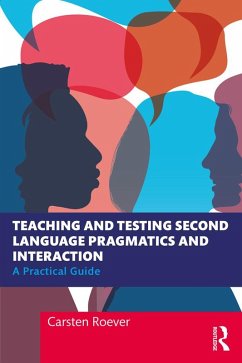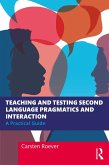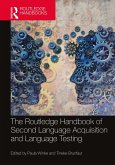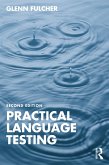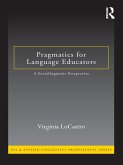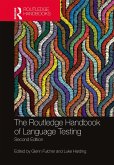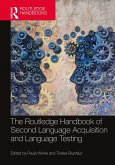Teaching and Testing Second Language Pragmatics and Interaction (eBook, ePUB)
A Practical Guide


Alle Infos zum eBook verschenken

Teaching and Testing Second Language Pragmatics and Interaction (eBook, ePUB)
A Practical Guide
- Format: ePub
- Merkliste
- Auf die Merkliste
- Bewerten Bewerten
- Teilen
- Produkt teilen
- Produkterinnerung
- Produkterinnerung

Hier können Sie sich einloggen

Bitte loggen Sie sich zunächst in Ihr Kundenkonto ein oder registrieren Sie sich bei bücher.de, um das eBook-Abo tolino select nutzen zu können.
Pragmatic ability is crucial for second language learners to communicate appropriately and effectively; however, pragmatics is underemphasized in language teaching and testing. This book remedies that situation by connecting theory, empirical research, and practical curricular suggestions on pragmatics for learners of different proficiency levels: It surveys the field comprehensively and, with useful tasks and activities, offers rich guidance for teaching and testing L2 pragmatics. Mainly referring to pragmatics of English and with relevant examples from multiple languages, it is an invaluable…mehr
- Geräte: eReader
- mit Kopierschutz
- eBook Hilfe
![Teaching and Testing Second Language Pragmatics and Interaction (eBook, PDF) Teaching and Testing Second Language Pragmatics and Interaction (eBook, PDF)]() Carsten RoeverTeaching and Testing Second Language Pragmatics and Interaction (eBook, PDF)38,95 €
Carsten RoeverTeaching and Testing Second Language Pragmatics and Interaction (eBook, PDF)38,95 €![The Routledge Handbook of Second Language Acquisition and Language Testing (eBook, ePUB) The Routledge Handbook of Second Language Acquisition and Language Testing (eBook, ePUB)]() The Routledge Handbook of Second Language Acquisition and Language Testing (eBook, ePUB)44,95 €
The Routledge Handbook of Second Language Acquisition and Language Testing (eBook, ePUB)44,95 €![Practical Language Testing (eBook, ePUB) Practical Language Testing (eBook, ePUB)]() Glenn FulcherPractical Language Testing (eBook, ePUB)38,95 €
Glenn FulcherPractical Language Testing (eBook, ePUB)38,95 €![Pragmatics for Language Educators (eBook, ePUB) Pragmatics for Language Educators (eBook, ePUB)]() Virginia LocastroPragmatics for Language Educators (eBook, ePUB)54,95 €
Virginia LocastroPragmatics for Language Educators (eBook, ePUB)54,95 €![The Routledge Handbook of Language Testing (eBook, ePUB) The Routledge Handbook of Language Testing (eBook, ePUB)]() The Routledge Handbook of Language Testing (eBook, ePUB)44,95 €
The Routledge Handbook of Language Testing (eBook, ePUB)44,95 €![Teaching and Learning Pragmatics (eBook, ePUB) Teaching and Learning Pragmatics (eBook, ePUB)]() Noriko IshiharaTeaching and Learning Pragmatics (eBook, ePUB)37,95 €
Noriko IshiharaTeaching and Learning Pragmatics (eBook, ePUB)37,95 €![The Routledge Handbook of Second Language Acquisition and Language Testing (eBook, PDF) The Routledge Handbook of Second Language Acquisition and Language Testing (eBook, PDF)]() The Routledge Handbook of Second Language Acquisition and Language Testing (eBook, PDF)44,95 €
The Routledge Handbook of Second Language Acquisition and Language Testing (eBook, PDF)44,95 €-
-
-
Dieser Download kann aus rechtlichen Gründen nur mit Rechnungsadresse in A, B, BG, CY, CZ, D, DK, EW, E, FIN, F, GR, HR, H, IRL, I, LT, L, LR, M, NL, PL, P, R, S, SLO, SK ausgeliefert werden.
- Produktdetails
- Verlag: Taylor & Francis eBooks
- Seitenzahl: 208
- Erscheinungstermin: 30. September 2021
- Englisch
- ISBN-13: 9780429536359
- Artikelnr.: 62504001
- Verlag: Taylor & Francis eBooks
- Seitenzahl: 208
- Erscheinungstermin: 30. September 2021
- Englisch
- ISBN-13: 9780429536359
- Artikelnr.: 62504001
- Herstellerkennzeichnung Die Herstellerinformationen sind derzeit nicht verfügbar.
1 Introduction
1.1 What is pragmatics and why does it matter?
1.2 Who this book is for (and some terminology you might need)
1.3 How this book is organized
2 Pragmatic competence and interactional competence
2.1 Pragmatics
2.2 How to talk to whom: pragmatic competence
2.2.1 Speech acts and politeness
2.2.2 Learning L2 speech acts
2.2.3 Conclusion
2.3 Understanding non-literal speech: implicature
2.3.1 Learning L2 implicature
2.4 Fixed expressions for fixed purposes: routine formulae
2.4.1 Learning L2 routines
2.4.2 Conclusion: Implicature and routine formulae
2.5 Interactional competence
2.5.1 Learning L2 interactional competence
2.5.2 Conclusion
2.6 Summary: Speech acts, implicature, routines and interactional
competence
2.7 Resources and further readings
3 Pragmatics and Curriculum
3.1 The CEFR and other frameworks: A brief introduction
3.2 A developmentally sensitive pragmatics curriculum
3.3 Pragmatics and proficiency levels
3.4 Beginners: The A1 level learner and pragmatics
3.4.1 Getting learners from 0 to A1
3.5 Upper Beginner / Low Intermediate: The A2 level learner and pragmatics
3.5.1 Getting learners from A1 to A2
3.6 Intermediate: The B1 level learner and pragmatics
3.6.1 Getting learners from A2 to B1
3.7 Upper-intermediate: The B2 learner and pragmatics
3.7.1 Getting learners from B1 to B2
3.8 Advanced: The C1 learner and pragmatics
3.8.1 Getting learners from B2 to C1
3.9 The high advanced learner: Pragmatics at the C2 level
3.9.1 Getting learners from C1 to C2
3.10 Resources and further readings
3.11 Conclusion
4 How to make teaching materials and tests for pragmatics
4.1 The basics: How to establish context
4.2 Metapragmatic judgments
4.2.1 Variations on metapragmatic judgment tasks
4.2.2 Procedure: administering metapragmatic judgment tasks
4.2.3 Resources and further reading
4.3 Multiple choice tasks
4.3.1 Creating multiple choice items for routines
4.3.2 Creating multiple choice items for implicature
4.3.3 Creating multiple choice items for speech acts
4.3.4 Procedure: administering multiple choice tasks
4.3.5 Beyond multiple choice: Multi-response tasks
4.3.6 Resources and further readings
4.4 Discourse completion tasks
4.4.1 Types of DCTs
4.4.2 Designing DCTs
4.4.3 Procedure: Administering DCTs
4.4.4 Resources and further readings
4.5 Role plays
4.5.1 Types of role plays
4.5.2 Target features in role plays
4.5.3 Role play scenarios
4.5.4 Interlocutor considerations
4.5.5 Procedure: how to run role plays
4.5.6 Resources and further readings
4.6 Elicited conversation
4.6.1 Designing elicited conversation tasks
4.6.2 Procedure: how to run elicited conversation tasks
4.6.3 Resources and further readings
5 Teaching pragmatics
5.1 Overview: Findings and issues in teaching L2 pragmatics
5.1.1 Effectiveness of teaching L2 pragmatics
5.1.2 Factors in teaching pragmatics
5.2 Materials for teaching pragmatics
5.3 Phases of a pragmatics lesson
5.3.1 Step 1: Presenting the target feature
5.3.2 Step 2: Receptive practice
5.3.3 Step 3: Productive practice
5.4 Teaching a feature across levels
5.4.1 Requests at A1 level
5.4.2 Requests at B1 level
5.4.3 Requests at C1 level
5.5 Resources and further readings
6 Testing pragmatics
6.1 Pragmatics testing so far
6.2 Testing in pragmatics research
6.3 Pragmatic norms
6.4 Assessing learning: classroom-based testing of pragmatics and
interaction
6.5 How to make sure tests work: validation of large-scale tests
6.6 Validating "objective" tests
6.7 Validating sociopragmatic judgment tests
6.8 Validating productive tests and their rating scales
6.9 Fairness and bias in testing of pragmatics
6.10 Conclusion
6.11 Resources and further readings
7 Outlook: The future of teaching and testing of L2 pragmatics
7.1 Pragmatics in general language teaching
7.2 Specific purposes pragmatics: needs analyses, tasks, and indigenous
criteria
7.3 Making pragmatics tests practical: the role of technology
8 References
1 Introduction
1.1 What is pragmatics and why does it matter?
1.2 Who this book is for (and some terminology you might need)
1.3 How this book is organized
2 Pragmatic competence and interactional competence
2.1 Pragmatics
2.2 How to talk to whom: pragmatic competence
2.2.1 Speech acts and politeness
2.2.2 Learning L2 speech acts
2.2.3 Conclusion
2.3 Understanding non-literal speech: implicature
2.3.1 Learning L2 implicature
2.4 Fixed expressions for fixed purposes: routine formulae
2.4.1 Learning L2 routines
2.4.2 Conclusion: Implicature and routine formulae
2.5 Interactional competence
2.5.1 Learning L2 interactional competence
2.5.2 Conclusion
2.6 Summary: Speech acts, implicature, routines and interactional competence
2.7 Resources and further readings
3 Pragmatics and Curriculum
3.1 The CEFR and other frameworks: A brief introduction
3.2 A developmentally sensitive pragmatics curriculum
3.3 Pragmatics and proficiency levels
3.4 Beginners: The A1 level learner and pragmatics
3.4.1 Getting learners from 0 to A1
3.5 Upper Beginner / Low Intermediate: The A2 level learner and pragmatics
3.5.1 Getting learners from A1 to A2
3.6 Intermediate: The B1 level learner and pragmatics
3.6.1 Getting learners from A2 to B1
3.7 Upper-intermediate: The B2 learner and pragmatics
3.7.1 Getting learners from B1 to B2
3.8 Advanced: The C1 learner and pragmatics
3.8.1 Getting learners from B2 to C1
3.9 The high advanced learner: Pragmatics at the C2 level
3.9.1 Getting learners from C1 to C2
3.10 Resources and further readings
3.11 Conclusion
4 How to make teaching materials and tests for pragmatics
4.1 The basics: How to establish context
4.2 Metapragmatic judgments
4.2.1 Variations on metapragmatic judgment tasks
4.2.2 Procedure: administering metapragmatic judgment tasks
4.2.3 Resources and further reading
4.3 Multiple choice tasks
4.3.1 Creating multiple choice items for routines
4.3.2 Creating multiple choice items for implicature
4.3.3 Creating multiple choice items for speech acts
4.3.4 Procedure: administering multiple choice tasks
4.3.5 Beyond multiple choice: Multi-response tasks
4.3.6 Resources and further readings
4.4 Discourse completion tasks
4.4.1 Types of DCTs
4.4.2 Designing DCTs
4.4.3 Procedure: Administering DCTs
4.4.4 Resources and further readings
4.5 Role plays
4.5.1 Types of role plays
4.5.2 Target features in role plays
4.5.3 Role play scenarios
4.5.4 Interlocutor considerations
4.5.5 Procedure: how to run role plays
4.5.6 Resources and further readings
4.6 Elicited conversation
4.6.1 Designing elicited conversation tasks
4.6.2 Procedure: how to run elicited conversation tasks
4.6.3 Resources and further readings
5 Teaching pragmatics
5.1 Overview: Findings and issues in teaching L2 pragmatics
5.1.1 Effectiveness of teaching L2 pragmatics
5.1.2 Factors in teaching pragmatics
5.2 Materials for teaching pragmatics
5.3 Phases of a pragmatics lesson
5.3.1 Step 1: Presenting the target feature
5.3.2 Step 2: Receptive practice
5.3.3 Step 3: Productive practice
5.4 Teaching a feature across levels
5.4.1 Requests at A1 level
5.4.2 Requests at B1 level
5.4.3 Requests at C1 level
5.5 Resources and further readings
6 Testing pragmatics
6.1 Pragmatics testing so far
6.2 Testing in pragmatics research
6.3 Pragmatic norms
6.4 Assessing learning: classroom-based testing of pragmatics and interaction
6.5 How to make sure tests work: validation of large-scale tests
6.6 Validating "objective" tests
6.7 Validating sociopragmatic judgment tests
6.8 Validating productive tests and their rating scales
6.9 Fairness and bias in testing of pragmatics
6.10 Conclusion
6.11 Resources and further readings
7 Outlook: The future of teaching and testing of L2 pragmatics
7.1 Pragmatics in general language teaching
7.2 Specific purposes pragmatics: needs analyses, tasks, and indigenous criteria
7.3 Making pragmatics tests practical: the role of technology
8 References
1 Introduction
1.1 What is pragmatics and why does it matter?
1.2 Who this book is for (and some terminology you might need)
1.3 How this book is organized
2 Pragmatic competence and interactional competence
2.1 Pragmatics
2.2 How to talk to whom: pragmatic competence
2.2.1 Speech acts and politeness
2.2.2 Learning L2 speech acts
2.2.3 Conclusion
2.3 Understanding non-literal speech: implicature
2.3.1 Learning L2 implicature
2.4 Fixed expressions for fixed purposes: routine formulae
2.4.1 Learning L2 routines
2.4.2 Conclusion: Implicature and routine formulae
2.5 Interactional competence
2.5.1 Learning L2 interactional competence
2.5.2 Conclusion
2.6 Summary: Speech acts, implicature, routines and interactional
competence
2.7 Resources and further readings
3 Pragmatics and Curriculum
3.1 The CEFR and other frameworks: A brief introduction
3.2 A developmentally sensitive pragmatics curriculum
3.3 Pragmatics and proficiency levels
3.4 Beginners: The A1 level learner and pragmatics
3.4.1 Getting learners from 0 to A1
3.5 Upper Beginner / Low Intermediate: The A2 level learner and pragmatics
3.5.1 Getting learners from A1 to A2
3.6 Intermediate: The B1 level learner and pragmatics
3.6.1 Getting learners from A2 to B1
3.7 Upper-intermediate: The B2 learner and pragmatics
3.7.1 Getting learners from B1 to B2
3.8 Advanced: The C1 learner and pragmatics
3.8.1 Getting learners from B2 to C1
3.9 The high advanced learner: Pragmatics at the C2 level
3.9.1 Getting learners from C1 to C2
3.10 Resources and further readings
3.11 Conclusion
4 How to make teaching materials and tests for pragmatics
4.1 The basics: How to establish context
4.2 Metapragmatic judgments
4.2.1 Variations on metapragmatic judgment tasks
4.2.2 Procedure: administering metapragmatic judgment tasks
4.2.3 Resources and further reading
4.3 Multiple choice tasks
4.3.1 Creating multiple choice items for routines
4.3.2 Creating multiple choice items for implicature
4.3.3 Creating multiple choice items for speech acts
4.3.4 Procedure: administering multiple choice tasks
4.3.5 Beyond multiple choice: Multi-response tasks
4.3.6 Resources and further readings
4.4 Discourse completion tasks
4.4.1 Types of DCTs
4.4.2 Designing DCTs
4.4.3 Procedure: Administering DCTs
4.4.4 Resources and further readings
4.5 Role plays
4.5.1 Types of role plays
4.5.2 Target features in role plays
4.5.3 Role play scenarios
4.5.4 Interlocutor considerations
4.5.5 Procedure: how to run role plays
4.5.6 Resources and further readings
4.6 Elicited conversation
4.6.1 Designing elicited conversation tasks
4.6.2 Procedure: how to run elicited conversation tasks
4.6.3 Resources and further readings
5 Teaching pragmatics
5.1 Overview: Findings and issues in teaching L2 pragmatics
5.1.1 Effectiveness of teaching L2 pragmatics
5.1.2 Factors in teaching pragmatics
5.2 Materials for teaching pragmatics
5.3 Phases of a pragmatics lesson
5.3.1 Step 1: Presenting the target feature
5.3.2 Step 2: Receptive practice
5.3.3 Step 3: Productive practice
5.4 Teaching a feature across levels
5.4.1 Requests at A1 level
5.4.2 Requests at B1 level
5.4.3 Requests at C1 level
5.5 Resources and further readings
6 Testing pragmatics
6.1 Pragmatics testing so far
6.2 Testing in pragmatics research
6.3 Pragmatic norms
6.4 Assessing learning: classroom-based testing of pragmatics and
interaction
6.5 How to make sure tests work: validation of large-scale tests
6.6 Validating "objective" tests
6.7 Validating sociopragmatic judgment tests
6.8 Validating productive tests and their rating scales
6.9 Fairness and bias in testing of pragmatics
6.10 Conclusion
6.11 Resources and further readings
7 Outlook: The future of teaching and testing of L2 pragmatics
7.1 Pragmatics in general language teaching
7.2 Specific purposes pragmatics: needs analyses, tasks, and indigenous
criteria
7.3 Making pragmatics tests practical: the role of technology
8 References
1 Introduction
1.1 What is pragmatics and why does it matter?
1.2 Who this book is for (and some terminology you might need)
1.3 How this book is organized
2 Pragmatic competence and interactional competence
2.1 Pragmatics
2.2 How to talk to whom: pragmatic competence
2.2.1 Speech acts and politeness
2.2.2 Learning L2 speech acts
2.2.3 Conclusion
2.3 Understanding non-literal speech: implicature
2.3.1 Learning L2 implicature
2.4 Fixed expressions for fixed purposes: routine formulae
2.4.1 Learning L2 routines
2.4.2 Conclusion: Implicature and routine formulae
2.5 Interactional competence
2.5.1 Learning L2 interactional competence
2.5.2 Conclusion
2.6 Summary: Speech acts, implicature, routines and interactional competence
2.7 Resources and further readings
3 Pragmatics and Curriculum
3.1 The CEFR and other frameworks: A brief introduction
3.2 A developmentally sensitive pragmatics curriculum
3.3 Pragmatics and proficiency levels
3.4 Beginners: The A1 level learner and pragmatics
3.4.1 Getting learners from 0 to A1
3.5 Upper Beginner / Low Intermediate: The A2 level learner and pragmatics
3.5.1 Getting learners from A1 to A2
3.6 Intermediate: The B1 level learner and pragmatics
3.6.1 Getting learners from A2 to B1
3.7 Upper-intermediate: The B2 learner and pragmatics
3.7.1 Getting learners from B1 to B2
3.8 Advanced: The C1 learner and pragmatics
3.8.1 Getting learners from B2 to C1
3.9 The high advanced learner: Pragmatics at the C2 level
3.9.1 Getting learners from C1 to C2
3.10 Resources and further readings
3.11 Conclusion
4 How to make teaching materials and tests for pragmatics
4.1 The basics: How to establish context
4.2 Metapragmatic judgments
4.2.1 Variations on metapragmatic judgment tasks
4.2.2 Procedure: administering metapragmatic judgment tasks
4.2.3 Resources and further reading
4.3 Multiple choice tasks
4.3.1 Creating multiple choice items for routines
4.3.2 Creating multiple choice items for implicature
4.3.3 Creating multiple choice items for speech acts
4.3.4 Procedure: administering multiple choice tasks
4.3.5 Beyond multiple choice: Multi-response tasks
4.3.6 Resources and further readings
4.4 Discourse completion tasks
4.4.1 Types of DCTs
4.4.2 Designing DCTs
4.4.3 Procedure: Administering DCTs
4.4.4 Resources and further readings
4.5 Role plays
4.5.1 Types of role plays
4.5.2 Target features in role plays
4.5.3 Role play scenarios
4.5.4 Interlocutor considerations
4.5.5 Procedure: how to run role plays
4.5.6 Resources and further readings
4.6 Elicited conversation
4.6.1 Designing elicited conversation tasks
4.6.2 Procedure: how to run elicited conversation tasks
4.6.3 Resources and further readings
5 Teaching pragmatics
5.1 Overview: Findings and issues in teaching L2 pragmatics
5.1.1 Effectiveness of teaching L2 pragmatics
5.1.2 Factors in teaching pragmatics
5.2 Materials for teaching pragmatics
5.3 Phases of a pragmatics lesson
5.3.1 Step 1: Presenting the target feature
5.3.2 Step 2: Receptive practice
5.3.3 Step 3: Productive practice
5.4 Teaching a feature across levels
5.4.1 Requests at A1 level
5.4.2 Requests at B1 level
5.4.3 Requests at C1 level
5.5 Resources and further readings
6 Testing pragmatics
6.1 Pragmatics testing so far
6.2 Testing in pragmatics research
6.3 Pragmatic norms
6.4 Assessing learning: classroom-based testing of pragmatics and interaction
6.5 How to make sure tests work: validation of large-scale tests
6.6 Validating "objective" tests
6.7 Validating sociopragmatic judgment tests
6.8 Validating productive tests and their rating scales
6.9 Fairness and bias in testing of pragmatics
6.10 Conclusion
6.11 Resources and further readings
7 Outlook: The future of teaching and testing of L2 pragmatics
7.1 Pragmatics in general language teaching
7.2 Specific purposes pragmatics: needs analyses, tasks, and indigenous criteria
7.3 Making pragmatics tests practical: the role of technology
8 References
